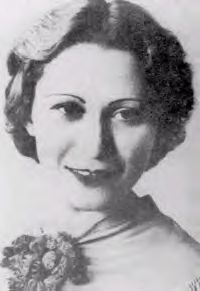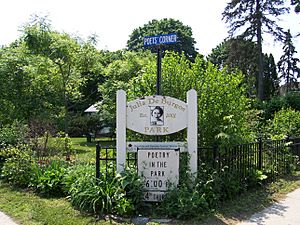Julia de Burgos facts for kids
Quick facts for kids
Julia de Burgos
|
|
|---|---|

Julia de Burgos
|
|
| Born | Julia Constancia Burgos García February 17, 1914 Carolina, Puerto Rico |
| Died | July 6, 1953 (aged 39) Manhattan, New York, United States |
| Occupation | Poet, activist |
| Nationality | Puerto Rican |
| Period | 20th century |
| Genre | Lyric poetry, lament |
| Literary movement | Puerto Rican Independence |
| Notable works | El Rio Grande de Loiza; Yo misma fui mi ruta; A Julia De Burgos |
Julia de Burgos García (born February 17, 1914 – died July 6, 1953) was a famous Puerto Rican poet. She was a strong supporter of Puerto Rican independence. She also worked as an activist for women's rights and for writers of African and Afro-Caribbean backgrounds.
Contents
Early Life of Julia de Burgos
Julia Constanza Burgos García was born in Carolina, Puerto Rico. Her father, Francisco Burgos Hans, was a farmer and part of the Puerto Rico National Guard. Julia was the oldest of thirteen children. Sadly, six of her younger brothers and sisters passed away from not having enough food.
She finished Muñoz Rivera Primary School in 1928. Her family then moved to Rio Piedras. There, she received a scholarship to attend University High School. In 1931, she started studying at the University of Puerto Rico, Rio Piedras Campus to become a teacher.
In 1933, at age 19, Julia graduated from the University of Puerto Rico with a teaching degree. She became a teacher at Feijoo Elementary School in Naranjito, Puerto Rico. She also wrote for a children's radio show. Some of her early inspirations were poets like Luis Lloréns Torres and Pablo Neruda. Julia once said, "My childhood was all a poem in the river."
Her Fight for Change
In 1934, Julia married Ruben Rodriguez Beauchamp. She stopped teaching after this. In 1936, she joined the Puerto Rican Nationalist Party. This party was led by Pedro Albizu Campos. Julia was chosen to be the Secretary General of the Daughters of Freedom. This was the women's group within the party. She divorced her husband in 1937.
Her Amazing Poetry
By the early 1930s, Julia de Burgos was already publishing her writing. Her poems appeared in different journals and newspapers. She released three books of her poems during her lifetime. To share her first two books, she traveled all around Puerto Rico. She would give readings of her poems. Her third book was published after her death in 1954.
Julia's poems often combined personal feelings with themes about the land. They also spoke about the struggles of people who were treated unfairly. Many experts say her poetry was ahead of its time. It explored ideas that later feminist writers and poets would also write about. In one poem, she wrote: "I am life, strength, woman."
Julia received awards and praise for her work. Famous poets like Pablo Neruda admired her. He met her in Cuba and said she was meant to be one of the greatest poets in the Americas.
Some of Julia de Burgos's well-known works include:
- El Rio Grande de Loiza
- Poema para Mi Muerte (My Death Poem)
- Yo Misma Fui Mi Ruta (I Was My Own Path)
- Alba de Mi Silencio (Dawn of My Silence)
- Alta Mar y Gaviota
Later Years and Legacy
Later in her life, Julia de Burgos traveled to Cuba and then to New York City. In New York, she worked as a journalist for a newspaper called Pueblos Hispanos. She also took on other jobs to support herself. In 1943, she married Armando Marín, a musician.
In February 1953, Julia wrote one of her last poems. It was called "Farewell in Welfare Island." She wrote it while she was in the hospital. Many people believe it was one of the only poems she wrote in English.
Her Passing
On June 28, 1953, Julia de Burgos left a relative's home in Brooklyn. She was later found to have collapsed in Manhattan on July 6, 1953. She passed away from pneumonia in a hospital in Harlem. She was 39 years old.
Because she had no identification and no one claimed her body, the city buried her. This burial took place on Hart Island. This island is a public cemetery.
Eventually, her friends and family found out what happened. They located her grave and claimed her body. A group in Puerto Rico worked to bring her remains back home. Julia's body arrived on September 6, 1953. Her funeral was held at the Puerto Rican Atheneum. She received a hero's burial in the Municipal Cemetery of Carolina. Later, a monument was built at her burial site.
Honors and Tributes
Julia de Burgos has been honored in many ways. In 1986, the University of Puerto Rico gave her a special doctorate degree after her death.
Many cities have honored Julia de Burgos. These include:
- Carolina, Puerto Rico
- Escuela Julia de Burgos (Julia de Burgos School)
- Cleveland, Ohio
- Julia De Burgos Cultural Arts Center
- New York City, New York
- Julia de Burgos Cultural Center
- Julia de Burgos Boulevard (a street corner)
- Julia de Burgos Middle School (M.S. 99)
- Philadelphia, Pennsylvania
- Julia de Burgos Elementary School
- Julia de Burgos Magnet Middle School
- Chicago, Illinois
- Julia de Burgos Park
- San Juan, Puerto Rico
- Casa Protegida Julia de Burgos (a shelter for domestic violence)
- Willimantic, Connecticut
- Julia de Burgos Pocket Park
The Puerto Rican sculptor Tomás Batista created a statue of Julia de Burgos. It is located in the Julia de Burgos Park in Carolina. A book about her and another poet was written by Isabel Cuchí Coll. Poet Giannina Braschi also honored Julia in her novel Yo-Yo Boing!
At Yale University, the Latino Cultural Center is named in her honor. It is called La Casa Cultural Julia de Burgos.
A documentary about Julia's life was made in 2002. It was called "Julia, Toda en mi ... " (Julia, All in me ... ). Another movie about her life was released in Puerto Rico in 1978.
On September 14, 2010, the United States Postal Service honored Julia. They released a first-class postage stamp with her picture. This stamp was part of their Literary Arts series.
In 2011, Julia de Burgos was added to the New York Writers Hall of Fame.
There is a special plaque in Mayagüez, Puerto Rico. It honors the women of the Puerto Rican Nationalist Party. Julia's name is on this plaque.
In 2014, the Legislative Assembly of Puerto Rico honored 12 important women. They placed plaques for them in a plaza in San Juan. Julia de Burgos was one of these honored women.
In 2018, The New York Times published a special obituary for her.
In Music
The composer Leonard Bernstein used Julia de Burgos's poem "A Julia de Burgos" in his work Songfest: A Cycle of American Poems for Six Singers and Orchestra. The music is very rhythmic.
Composer Awilda Villarini also set some of Julia de Burgos's poems to music.
Julia de Burgos Quotes
- "You curl your hair and paint your face. Not I: I am curled by the wind, painted by the sun."
- "Don't let the hand you hold hold you down."
- "I am life, I am strength, I am woman."
See also
 In Spanish: Julia de Burgos para niños
In Spanish: Julia de Burgos para niños


